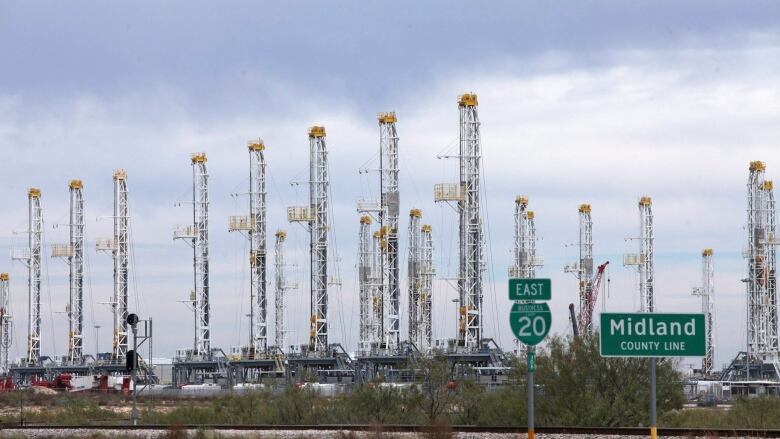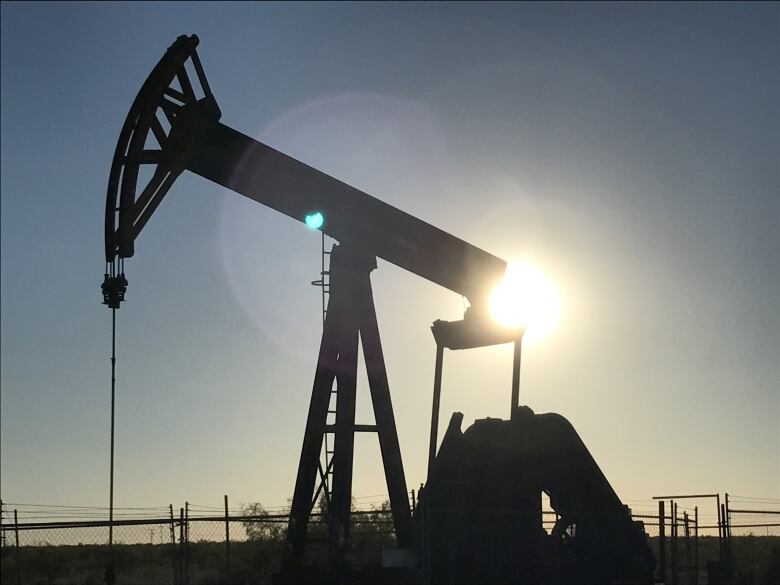What U.S. shale's woes mean for Canada's oil and gas industry
American oil output could hit 2-year low this month, forecast predicts

The rise of the U.S.shale oil sector shook up energy markets worldwide, but the economic wallop of the pandemic is now rattling that same industry to the core.
The situation has led to billions of dollars of losses and fears of a wave of bankruptcies, while some believe a recovery could be at least a year away or even more.
Shale's struggles are making news around the globe and could have various implications for the Canadian oil and gas sector, whether it's on prices or discussions on energy security.
"What we're seeing right now is a very rapid response to the COVID-19-led demand shock and price collapse," said analyst Kevin Birnwith IHS Markit.
The most immediate effect has been on oil.
As lockdowns took place across North America, demand for fuel collapsed as did the price of crude oil, which briefly turned negative for the first time in April.
With prices plunging, Canadian companies curtailed production by at least 800,000 barrels per day. But cuts south of the border have been larger and have come on faster than some expected.

Rystad Energy expects American production to bottom out at 10.7 million barrels per day (bpd) in June, down 2.2 million bpd from March.
U.S. monthly output is not likely to exceed 11.7 million bpd before 2022, "a staggering difference from the nearly 12.9 million bpd achieved in March 2020," Rystad said in a note last week.
The shut-in of so much production has helped bolster the benchmark price for a barrel of North American crude into the mid-$30s US.Historic cuts by members of the OPEC oil cartel and optimism surrounding the openingof economies are also key factors.
Though current prices down roughly40 per cent from the start of the year are far from great, they should help improve company cash flows even if they don't lead to a big ramp-up in production.
Oil inventories still high
But oil markets still face significant challenges, including the unpredictability of the pandemic.
Birn said he is hesitant to get too excited, despite signs that the lowest point of the oil price collapse may now be behind the industry.

"This supply that's been pulled off in rapid succession both in North America, and also OPEC, also will come back into the market and inventories remain at record highs," he said.
"These factors are going to weigh on price for a while."
Birn also expects the U.S. oil exports to fall, meaning its contribution to meeting global oil demand could slip through the period.
With falling crude production in North America, the U.S. may also face having to import more oil from overseas and Canada's share may decline as a share of the total, he said.
That means North American self-sufficiency in energy could decline.
"Canada and the United States were each other's largest source of foreign oil," Birn said.
"While Canada will remain the U.S. primary source of imports, the North American reliance on offshore imports could increase."
Natural gas prices could rise
The implications of slowing U.S. shale production aren't limited to crude oil.
It may also have an impact on the natural gas sector by helping lift prices moving into late 2020, said Morgan Kwan of RS Energy Group, now part of Enverus.
"Because we've seen such a drastic downturn in U.S. shale production, especially in the Permian, that means there's a significant cutback in associated gas production," she said.
"So this actually speaks really well for Canadian gas producers, whereas the last couple of years, Canadian gas prices have been pretty challenged."

Western Canada's natural gas sector has experienced some tough years due to low prices.
Kwan said AECO, the western Canadian gas benchmark price, hassince 2018been tradingfrom $1 US per million British thermal units (MMBTU)to $2 US per MMBTU, even periodically dropping below $1 US.
Over the next heating season this winter, RS Energy isforecasting AECO to strengthen within the $2.50 range.
"That doesn't seem like a lot, but for the Canadian gas producer, there's a lot of assets that open up with that input price," she said.
Martin King, a senior analyst at RBN Energy, said though things are looking better for Canadian natural gas, his view is one of "guarded optimism."
While he's hopeful lower associated gas supplies can help tighten the market and improve pricing, he's watching to see what happens with U.S. exports of liquefied natural gas (LNG).
- What the oilpatch thinks about the financial aid offered by Ottawa
- A day-by-day account in the west Texas oilfields as oil markets in a free fall
- Higher prices encourage Canadian producers to boost oil production
The U.S. has emerged as a global LNG producer but demand has weakened due to the impact of the COVID-19 pandemic. Gas stocks in many countries are also average or above.
"When we get to the winter, what is going to be a very interesting and unpredictable dynamic will be how much U.S. LNG exports get turned away by international buyers and pushed back to the U.S. market," King said.
"There's lots of gas out there."













_(720p).jpg)


 OFFICIAL HD MUSIC VIDEO.jpg)
.jpg)



























































































